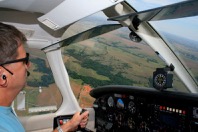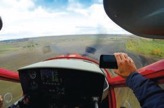“Managing Distractions”
Distractions and interruptions can severely compromise flight safety if they occur during critical phases of flight. To help prevent this, the General Aviation Joint Steering Committee (GAJSC) recommends awareness training on how to properly cope with interruptions and distractions while flying. General aviation pilots are particularly at risk because they usually do not have additional flight crew members to assist them.

Keep Your Focus
Interruptions and distractions may be brief, but they can be deadly. They can cause you to lose focus, which could lead to catastrophic errors.
Interruptions and distractions break your train of thought, but sometimes they can also convey information that is critical for safe flight. The key is to learn how to safely manage the inflow of competing information.
Examples of interruptions/distractions include air traffic control (ATC) communications or alerts, head-down work, or having to deal with an unexpected situation. If not managed properly, distractions can set a deadly chain of events in motion.
Pilots are trained to manage several tasks concurrently, and for the most part, this is a skill pilots execute well. However, it’s important not to become preoccupied with one task over all the others. Do you remember the December 1972 L-1011 crash, where the crew became so preoccupied with a landing gear light malfunction that they failed to notice that someone had erroneously turned off the autopilot? Similar events can happen to the GA pilot. Don’t let it happen to you!
Reduce the Risk
- Realize that you may have control over some interruptions and distractions, and not over others.
- Realize that the actions under your control, like head-down work, including standard operating procedures and checklists, should be conducted during periods of minimal disruption.
- Observe the FAA’s “sterile cockpit rule,” and make sure that passengers understand your need to focus at critical junctures of the flight.
- Keep communications clear and concise.
Responding to Abnormal Conditions
Because some interruptions and/or distractions may be subtle, the first priority is to recognize and identify them. Then, you will need to re-establish situational awareness. Identify what you were doing, and where you were in the process when you were distracted. Determine what action you need to take to get back on track.
Prioritization is key. Remember:
- Aviate
- Navigate
- Communicate, and
- Manage
Be ready to postpone some lower-priority actions until you are in a position to safely address them.
More Tips on Dealing with Distraction:
- Recognize that conversation is a powerful distracter
- Recognize that head-down tasks greatly reduce your ability to monitor the status of the aircraft
- Schedule or reschedule activities to minimize conflicts, especially during critical phases of flight. FAASafety.gov Download All Fact Sheets at bit.ly/GAFactSheets
- When two tasks must be performed at the same time, avoid letting your attention linger too long on either task
- Remember that your job as pilot in command is to fly the aircraft. That is your primary focus
- Treat interruptions as red flags
- Remember, “Interruptions Always Distract”
- Identify the interruption when it occurs.
- Ask, “What was I doing before I was interrupted?”
- Decide what action you will need to take to get back on track.
The Final Word…
Fly regularly with a flight instructor who will challenge you to review what you know, explore new horizons, and to always do your best. Be sure to document your achievement in the WINGS Proficiency Program. It’s a great way to stay on top of your game and keep your flight review current.
Resources
Pilot’s Handbook of Aeronautical Knowledge – Chapter 2 – Aeronautical Decision-Making www.faa.gov/regulations_policies/handbooks_manuals/aviation/phak
FAA Safety Briefing — “Why Do I Lockup in the Cockpit?” Sep/Oct 2019 https://adobe.ly/2ZDa8FK
FAA Safety Briefing — “When the Best Made Plans Go Awry,” Nov/Dec 2010 http://bit.ly/374dxgy
Reprinted with permission from FAA Safety Briefing. Visit the Flight Safety Briefing website: https://www.faa.gov/news/safety_briefing/.





